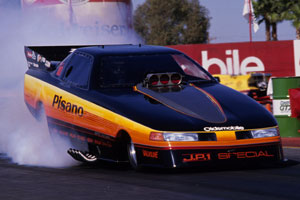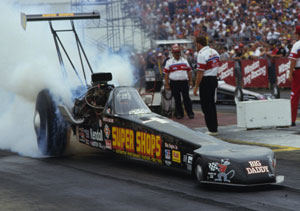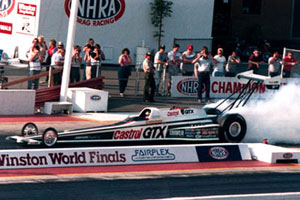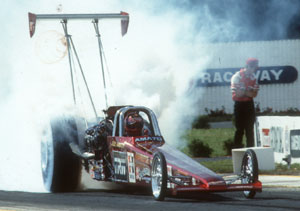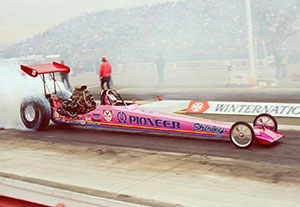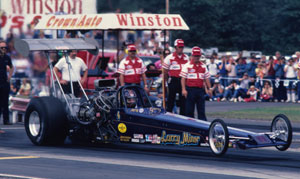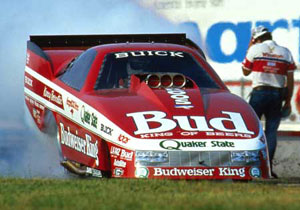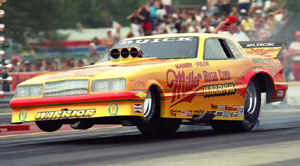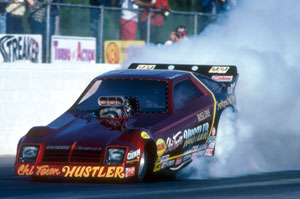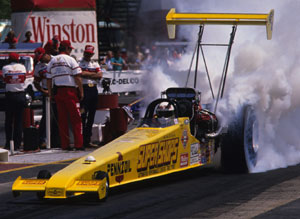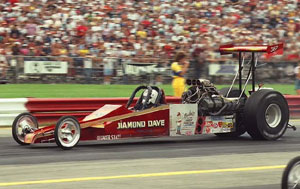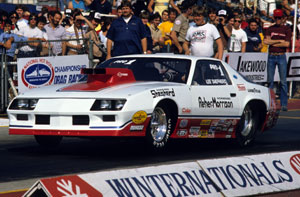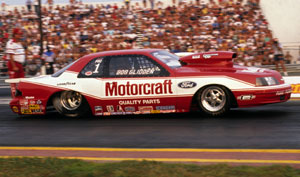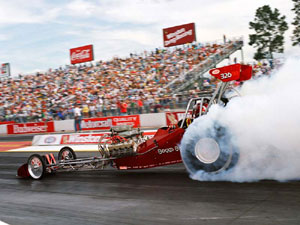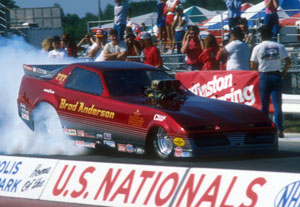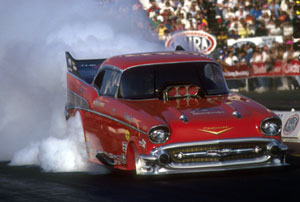

Favorite Race Car Ever voting: 1980s and Beyond
|
|
||
|
|
||
|
|
||
|
|
||
|
|
||
|
|
||
|
|
||
|
|
||
| Final results for favorite race car, 1980s and beyond | ||
| Don Garlits Swamp Rat XXX Top Fueler |
703
|
(18.49%) |
| Joe Pisano/Mike Dunn Olds Funny Car |
456
|
(12.00%) |
| Eddie Hill Super Shops Top Fueler |
447
|
(11.77%) |
| Chi-Town Hustler/Frank Hawley Funny Car |
340
|
(8.94%) |
| Bob Glidden Thunderbird Pro Stocker |
310
|
(8.17%) |
| Dale Pulde Miller Warrior Funny Car |
254
|
(6.69%) |
| Tom McEwen ‘57 Chevy Funny Car |
251
|
(6.59%) |
| Reher-Morrison Camaro Pro Stocker |
241
|
(6.34%) |
| Kenny Bernstein Batmobile Bud King Funny Car |
213
|
(5.60%) |
| Shirley Muldowney Pioneer Special Top Fueler |
143
|
(3.76%) |
| Gary Ormsby Castrol GTX streamliner Top Fueler |
123
|
(3.25%) |
| Joe Amato TRW Top Fueler |
86
|
(2.25%) |
| Ron Boggs altered Alcohol Dragster |
77
|
(2.03%) |
| Larry Minor/Gary Beck Top Fueler |
67
|
(1.77%) |
| “Diamond Dave” Miller shorty Top Fueler |
61
|
(1.61%) |
| Brad Anderson Firebird Top Alcohol Funny Car |
28
|
(0.74%) |
|
Total votes: 3800 (projected)
|
||
|
|
||
|
|
||
|
|
||
|
|
||
|
|
||
|
|
||
|
|
||
|
|
||
And so here we are, at the final qualifying poll for our Favorite Race Car Ever balloting, the nominations for which cover the 1980s through present day, and it’s a real mix and match. There are Top Fuelers, Funny Cars, Pro Stockers, and even some alcohol cars, each with its own niche that makes it special in the hearts of the nominators. Although this category was open to all cars from 1980 through 2008, not many on the list are from the 1990s or later.
Once this poll is complete, I hope early next week, I’ll set the final field of 16. As previously noted, all seven poll winners will advance, and I’ll select nine others to fill out the field. I’ve arrived at a pretty good formula (thanks, “T.V.” and “Little Brad”) to determine those nine that I’ll share in the future.
So, without further ado, put down your Rubik’s Cube, turn off those New Wave CDs and Dallas reruns, and get ready to relive the 1980s here. Fire the first pair!
Joe Pisano was known for having beautiful cars in his long career as an owner, from his candy-red Camaros and Vegas through the flamed Pisano & Matsubara Vegas and later his own Trans Ams, Arrows, Daytonas, Camaros, and Omnis, but it was a simple elegance that made his Oldsmobile Funny Cars, first a Firenza and then a Cutlass, of the late 1980s stand out. The black and gold JP-1 Special, bannering the name of his aluminum engine block, was driven by Mike Dunn and consistently set top speed of the meet. In their first year together, 1986, they won the U.S. Nationals and were runner-up the next year, when they also broke the 270- and 280-mph barriers, the latter with a speed that at the time was seven mph faster than that of the next closest competitor and remained the standard for almost two years. After three years and five event wins together, Dunn left the team at the end of the1990 season to partner with his dad and Pennsylvania businessman Ed Abel.
“I’d vote for any Pisano car because they were always so classy looking, ran great, and I loved Joe P.,” raved Pat "Ma" Green.
“What a beautiful black car,” agreed Ernest Sepulveda. “Very clean. Not many decals. All contingency sponsors hand-painted. The thing I loved most was that they still ran a 2-speed with no computer and broke 280 mph when no one else could. Mike Dunn in my opinion was one of the best drivers ever who also did his own clutch and other mechanical duties.”
Don Garlits’ famed Swamp Rat XXX is another well-loved black car that ran like hell, being the first to top 270 at the 1986 Gatornationals. With a canopy enclosing the driver’s compartment and the front ducked under a sleek nose, the car cut a mean aero shape and incited a lot of cars to follow. It was a big winner, scoring at the Gatornationals and Cajun Nationals before suffering a disastrous blowover at that year’s Summernationals that seals it in the memory books of many. The car, which was repaired and carried Garlits to that year’s NHRA world championship, has the honor of being the only drag racing vehicle in permanent residence in the Smithsonian National Museum of American History, to which it was presented Oct. 20, 1987.
Commented Tom “Fasthair” Scott, “ ‘Big Daddy’ is my hero and has been since I was old enough to say ‘Big Daddy.’ I built his first rear-engine rail when it first came out as a kid and later built the same car again in my 20s, but it was the large-scale model, my first and last large-scale build. Is there any more exciting race footage than when ‘Big’ did that gigantic wheelstand? It goes out to half-track and does 180 while standing straight up, slamming back to the earth going backwards at 200-plus mph with tires bellowing smoke. By the time ‘Big’ gets it shut down, he had coasted back to the starting line and gets out of it like it was any normal day at the races. The crowd went wild, and so did I in my chair at home.”
Garlits was not the only driver to heavily invest in a streamliner. Veteran Gary Ormsby, just two years into his comeback after a long hiatus from Top Fuel, and crew chief Lee Beard teamed with Indy-car aerodynamicist Eloisa Garza and others to create the swoopy Castrol GTX streamliner, which featured a totally enclosed engine compartment that also covered the rear wheels. Although the car ran well on occasion, it seemed cursed from its 1986 Pomona debut, when plug wires touching the inside of the engine cowl shorted and caused the blower to backfire in the water box. A later version also enclosed the front tires à la Garlits, but by mid-1987, they’d stripped the car of the fancy aero package and went back to a standard configuration.
You only have to rewind a few years to find the car that undoubtedly started the whole aero craze, Joe Amato’s Tim Richards-tuned TRW/Keystone Automotive Top Fueler. The car debuted at the 1984 Gatornationals with a rear wing so outrageously high and laid back that people literally did double takes; remember, we weren’t too far removed from rear wings being mere inches above the rear tires. Amato’s wing, designed by Indy-car engineer Eldon Rasmussen, took advantage of a simple law of leverage — anyone who’s ever slid a pipe over the end of a wrench to help bust loose a stubborn nut knows much more force can easily be applied — and the high and laid-back wing, positioned in “clean” air above the rear tires, increased downforce without adding drag, and the car immediately rocketed to the sport’s first 260-mph clocking. Within a few races, the Top Fuel pits looked like a forest, with tall wings sprouting off the backs of many cars. Amato won the Gatornats, Southern Nats, and NorthStar Nats and was runner-up at three races en route to his first of five world championships.
The two cars that preceded Amato’s to the Top Fuel throne also made the list. Shirley Muldowney’s pink Pioneer Special Top Fueler was a hard-running machine that carried her to her only U.S. Nationals triumph, in 1982, a win that was topped by a had-to-feel-good final-round victory over former crew chief and partner Connie Kalitta, 5.57 to 5.66, in the quickest side-by-side race in Top Fuel history; that match was voted the number-two most memorable U.S. Nationals moment in a 2004 salute. The car, which carried her to her third world championship in six seasons, also probably gave her some other satisfying final-round wins, including a Gatornationals triumph over longtime rival Garlits and a Southern Nationals score over up-and-coming female rival Lucille Lee that reversed a stinging loss to her a month earlier in the March Meet final. She also won in Brainerd that year, defeating the next car on our list.
From 1980 through the middle 1980s, the Gary Beck-driven Larry Minor machine thundered on the nation’s dragstrips and did something no other car has done: broke three performance barriers in three straight years. Beck barely lost the 1980 Top Fuel crown to Muldowney and the 1981 title to Jeb Allen, both at the final event of the season, but at the 1981 Finals at Orange County Int’l Raceway, Beck was the first to crack into the 5.5-second zone with a 5.57 run. The following year, he became the first in the 5.4s with a stunning 5.48 in Indy. Incredibly, Beck and the blue machine, tuned by current John Force co-crew chief Bernie Fedderly, then broke into the 5.3s in 1983 with back-to-back 5.39s at Fremont and Orange County. By the end of 1983, Beck, Minor, Fedderly, et al — the “Hemet Mob” — not only held the world championship but also 17 of the 18 quickest e.t.s in history.
“It was the most dominant car of that era and set low e.t. almost everywhere,” remembered Al Kean. “Its launches were so much stronger than any other car at the time; it was truly special to watch, and Gary Beck was a great driver. He deserved the '83 world title.”
Tricky aerodynamics were not limited to the dragsters, and some say that Kenny Bernstein, who revolutionized the flopper aero trend in 1984 with his Budweiser King Tempo, went a bit too far with his memorable/forgettable ‘87 Buick LeSabre, dubbed by some the Batmobile for its swoopier-than-stock looks and the Dump Truck for its obscenely large and flat rear deck. The car was the source of much controversy because although it fell within the guidelines of the class rules, it certainly did not maintain the spirit of the rules — loopholes NHRA closed for the following season — but that’s the type of forward thinking that made Bernstein and crew chief Dale Armstrong so successful throughout the years. The car was the first in the 5.3s at the All-Stars race, held that year at Texas Motorplex, and carried Bernstein to his third straight world championship
“There is a reason they call Kenny ‘the King of Speed,’ and that car is why,” noted the previously quoted Scott. “It was the baddest hot rod of the year and caused NHRA to ban the car the following year.”
Former ND Editor Bill Holland thinks that the car should be memorable if only for its affect on the class’ direction; “While I have the utmost respect and admiration for Kenny Bernstein,” he said, “it was his Batmobile Buick that started the trend from somewhat recognizable marques to ‘aerodynamic’ purebred race cars.”
Bernstein’s mount wasn’t the only Buick-bodied flopper to make the list; the Miller High Life Buick Regal of Dale Pulde and Mike Hamby also received several nominations. Pulde began racing Funny Cars in the late 1960s for the likes of Mickey Thompson and others and teamed with Hamby beginning in 1977 on a beautiful series of War Eagle machines, but many fans think that this car, which debuted in 1985, was their prettiest despite its unusual shape and name change, from War Eagle to Warrior (after securing the Miller sponsorship, they had to rechristen the car due to beer rival Anheuser-Busch’s well-known eagle logo, or so the story goes). Tuned by nitro genius Bill Schultz, the car won the IHRA world championship while finishing third in the NHRA chase.
It’s not easy to resurrect a legendary name, but when Austin Coil, John Farkonas, and Pat Minick decided to leave the match race trail and bring the Chi-Town Hustler back into the national spotlight in 1982, they probably exceeded even their own wildest dreams. With relative unknown Frank Hawley at the wheel and the car still carried inside an old-school ramp truck, they won the 1982 Gatornationals in just the second event of their return to the national event tour with the Charger-bodied car, then won the Springnationals and NorthStar Nationals, which, along with a pair of runner-ups, carried them to a stunning world championship; they even won the Big Bud Shootout to boot. They repeated their championship in 1983 with four more national event wins and were huge fan favorites not just for their performance but also for their aw-shucks, low-budget approach to racing.
“Back in 1983, I lived on a little farm in a small town in Iowa out in the middle of nowhere,” recalled the prolific and aforementioned Scott. “I go to the gas station by the interstate, and what do I see? Yup, the Chi-Town Hustler transporter. Now this was before the big rigs of today. Just a little box truck with a ramp to load the car on and put everything else anywhere it would fit. I walk inside, and there stands Mr. Hawley himself. Not many drive their own rigs these days. Anyway, I’m stunned and ask, ‘Are you Frank Hawley and is that the world-famous Chi-Town Hustler?’ Frank, being the low-key guy he is, just said, ‘Yes it is,’ and opened up the rear door and let me have a peek at it. I thought I had died and gone to heaven. I had never been to a drag race at this point in my life, much less a real honest-to-God fuel Funny Car. Needless to say, that car has always held a special place in my heart.”
Speaking of huge followings, from the mid-1980s through the early 1990s, there might not have been a bigger fan favorite than Eddie Hill. The well-loved Texan, a Top Fuel racer in the 1960s who won and set records in everything from drag boats to motorcycles before returning to Top Fuel in 1985, was a feared threat with wife Ercie and crew chief Terry “Fuzzy” Carter. It took him almost a year to win his first round of competition, but the team really hit its stride in 1988 with the car on this poll, the Super Shops/Pennzoil dragster, dubbed the Nuclear Banana. On April 9, 1988, with this car, which featured a slightly shorter wheelbase than its competitors, Hill became the first Top Fuel driver to run in the four-second zone and later that year ran as quick as 4.93. Five years later, Hill won his first NHRA world championship.
And speaking of short cars, former alcohol racer “Diamond Dave” Miller made a splash in 1986 with a real shorty Top Fueler, and, in a rare oddity, it ran almost as weird as it looked. Designed by Dennis Rolain of R&B Engineering, the car sported a 200-inch wheelbase when most of its contemporaries were in the 280-inch range. Miller raced Top Fuel from 1976 through 1984 without making much noise, but when he debuted this car in 1984, it became an instant fan favorite. He ran the car through the 1989 season and ran a best 5.37 at 260 mph.
Favorite cars certainly don’t have to be blown on nitro to qualify for the poll, and two of the all-time great Pro Stock machines of the 1980s are evidence.
With four straight world championships from 1981 through 1984, the Reher-Morrison Camaros of tuners and engine builders Buddy Morrison and David Reher and wheelman Lee Shepherd were an unstoppable force in the early 1980s with theirwhite and red Chevys out of Arlington, Texas., until Shepherd’s death in a March 1985 testing accident. After a couple of runner-ups in the late 1970s, they began the new decade with a bang, winning the first three races of the season and three more that year — including Indy — but lost the championship on a broken transmission at the season finale. Undaunted, they won six times in 1981 — including Indy again — to win their first of four straight championships. In 1983, Shepherd became the first driver to win both the NHRA and IHRA Pro Stock championships — a feat he repeated the following year. He won every race on the NHRA tour at least once and compiled a 173-47 record. From 1980 to 1984, Shepherd reached the final at 44 of 56 NHRA national events, winning 26 of them.
Chris Williams, who remembers Shepherd’s kindness to him as a young fan at the 1981 Summernationals, taking time to talk to him while preparing the car, has a soft spot for the team for that reason and others. “My father was a Chevy man,” he wrote. “As we all remember, in the early ‘80s, there were four cars that completely dominated Pro Stock: Bob Glidden was out for me; after all, he drove a Ford. Warren Johnson was out too 'cause he didn't drive a Chevy. Frank Iaconio was a Chevy dude, but I just couldn't get into that yellow/black paint scheme. Lee Shepherd was the driver for me, hands down. That simple Reher & Morrison paint scheme was so cool to me. White and red with a blue pinstripe. It didn't hurt that those three colors gave that Camaro a certain patriotic theme.”
Acknowledged Dave Squad, “Even though I am a Ford fan, Lee Shepherd was one of the best and most popular drivers of his time.”
And because there’s no greater rivalry than Chevy versus Ford, here’s the other side of the coin and the driver and car considered by many the class’ best ever: Bob Glidden’s Thunderbird, which carried him to world championships in 1985, ’86, ’87, and ’88. For sure, Glidden had great success in other cars, including his early Ford Pintos and his all-conquering Fairmont, winning five championships (1974-75 and 1978-80), but the T-birds, the first of which he received in mid-1984, were the dominant cars in the last half of the 1984 season and for all of 1985. In 1985, Glidden led the points chase from start to finish, winning five national events and his sixth title. Despite a devastating crash the next year in Atlanta, he won six of the season’s final seven events to again earn the championship, and in 1987, he won eight of 14 races and qualified No. 1 at all 14. After winning the 1988 title, Glidden retired the Thunderbird, which had won 19 national events, in favor of a sleeker Ford Probe, which continued his winning legacy.
“I am a Chevy guy personally,” said reader Rick Atchley, “but I’ll always remember Glidden outrunning everyone with the only Ford entered in the class.”
“Just awesome,” agreed Paul Godfrey. “Not many were tougher on track.”
The Boggs brothers, Ron and Steve, put a charge into the Top Alcohol Dragster ranks in the late 1980s with their altered entry. By extending the wheelbase of their existing blown alcohol altered to 150 inches, they were able to fit into the TAD class, and the addition of a huge dragster-style rear wing only added to the attraction. The car was campaigned from 1986 to 1990 and, after the addition of a PSI screw-type supercharger, ran a best of just 6.10 but never won any major races, although it did reach the semifinals at the U.S. Nationals in 1989, much to the crowd’s delight. Ron retired from driving, but Steve has been active, tuning drivers such as Tony Bartone, Joe Penland, and Mitch Myers to championships in the alcohol classes and working with a who’s who of the methanol ranks before making the transition to nitro racing.
With 24 national event wins, eight Division 7 crowns, and three season championships, it’s no wonder they call him “Bad Brad,” and Brad Anderson’s Trans Am Top Alcohol Funny Car of the early 1980s helped cement that nickname. After a series of successful blown gassers, Anderson switched to Top Alcohol Funny Car in the late 1970s. He won his first national event at the 1981 Winternationals and closed that season with back-to-back victories at the Golden Gate Nationals and World Finals in a Plymouth Horizon, but his new-for-1982 Trans Am upped the ante. The car was unequalled in performance and was the first alky burner to top 220 mph. He repeated that season-ending double play in 1982 and won the Finals for a third straight year in a one-win 1983 campaign before embarking on his greatest season in 1984. He won six races that year — including Indy — and his first season championship and amassed a 23-2 win-loss record.
After his Coors sponsorship ended in 1987, Tom McEwen wasn’t about to sit idle and dreamed up a ’57 Chevy Funny Car that was a hit with fans on exhibition passes in the late 1980s; it was a nostalgia Funny Car ahead of its time. After trying to piece together a body from doorslammer parts, McEwen commissioned Steve Davis to make a one-off body, a process that took a year but proved well worth it. By adding just 13 inches to the length and refusing to chop the top or streamline the nose, the body remained relatively stock-appearing. Despite the weight of the heavily reinforced body, its lack of aerodynamics, and light nitro load, when dropped over his Corvette chassis, the car ran as quick as 5.72 at 265.70 mph. McEwen ran the car for three years before he returned to competition in Jack Clark’s Top Fueler. Today the car resides in the showroom of Southern California-based Danchuk Manufacturing, builder of aftermarket parts for ’55-57 Chevys, and McEwen had his own 1/16th-scale models built of the car, including a real fiberglass body, that are sold at Prestige Hobbies in Anaheim, Calif.

| Final results for all-time favorite '70s Funny Car! | ||
| “Jungle Jim” Liberman Vega |
1033
|
(27.03%) |
| Raymond Beadle Blue Max Mustang II |
741
|
(19.39%) |
| Don Prudhomme Army Monza |
475
|
(12.43%) |
| Don Prudhomme Hot Wheels ‘Cuda |
290
|
(7.59%) |
| Barry Setzer/Pat Foster Vega |
277
|
(7.25%) |
| John Force Wendy's Corvette |
175
|
(4.58%) |
| Ed McCulloch Revellution Dodge |
157
|
(4.11%) |
| Dunn & Reath Barracuda |
144
|
(3.77%) |
| Roger Lindamood Color Me Gone |
124
|
(3.24%) |
| Don Schumacher Wonder Wagon |
78
|
(2.04%) |
| Tom McEwen Hot Wheels Duster |
77
|
(2.01%) |
| Black Magic Vega |
75
|
(1.96%) |
| Pisano & Matsubara Vega |
75
|
(1.96%) |
| Larry Fullerton ‘72 Trojan Horse |
49
|
(1.28%) |
| Keeling & Clayton Mustang |
26
|
(0.68%) |
| Condit Bros./Beaver L.A. Hooker |
26
|
(0.68%) |
|
Total Votes: 3800
|
||
Voting closed over the weekend in the 1970s Funny Car class when we topped the 3,800-vote cutoff — not that the winner hadn’t been determined early on as “Jungle Jim” Liberman won his second poll in convincing, wire-to-wire fashion. “Jungle’s” ’66 Chevy II won the 1960s Funny Cars poll, so it’s going to be interesting to see how the legions of “Jungle” fans divvy up the vote in the final when they have to pick one or the other.
Raymond Beadle’s three-time NHRA championship-winning Blue Max finished a decent but distant second ahead of the Don Prudhomme entries, his early 1970s ’Cudas and his all-conquering Army Monza. I had read online in one of the forums that people thought that the two Prudhomme entries would cannibalize one another and prevent “the Snake” from winning, but the totals of the two would barely have been enough to shoot the Max out of the second spot.
The 1970s Top Fuelers poll has been slowly nearing the cutoff mark, with slightly more than 200 votes to go as of Monday morning. It’s growing by about 100 votes a day, but with each new entry added above it, it gets pushed farther down the page and without reminders such as this one might get overlooked by first-time visitors. I’ve been tracking the votes since Tuesday, and the voting trends have not changed, so even if we don’t get to 3,800 votes, I can extrapolate the numbers with certainty that the results will be the same.
With any luck, the current poll for the 1980s and beyond will be complete by a week from today, and then we can set up the final and really have at it. Here’s the field so far, listing just the winners:
1. Willie Borsch Winged Express
2. Stone-Woods-Cook Willys
3. The Freight Train
4. Jim Liberman ’66 Chevy II
5. Jim Liberman ’73 Vega
I can say with 99 percent certainty that, barring a rally by Warren-Coburn-Miller fans, Don Garlits’ Swamp Rat 22 (the 5.63 car) will win the 1970s Top Fueler poll. The winner of the 1980s and Beyond poll will be the seventh winner, and then I will fill the remaining nine spots with second-place (and, possibly third-place) finishers based on the percentage of votes they received of the pool of votes that do not include the winner. Because all polls are not created equal (based on the depth of the field nominees), I think that’s the only fair way.
Okay, that’s it for today. Start voting!




















































